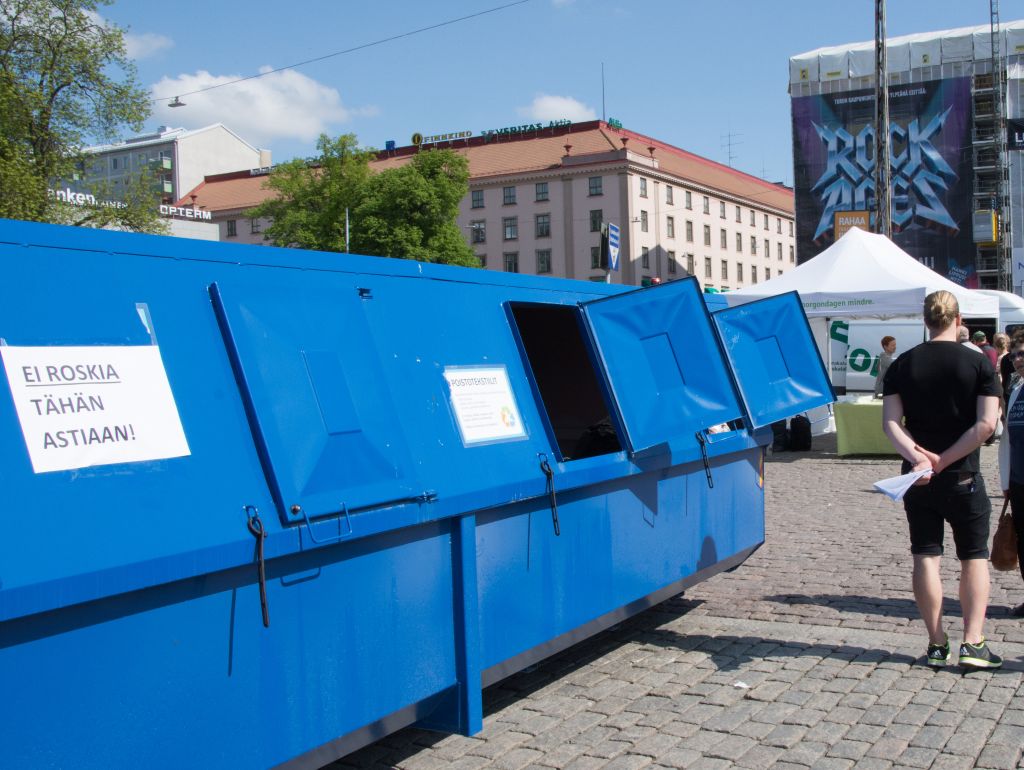The resident is the first link in a chain of textile recycling


A T-shirt Vera bought from a discount shop falls apart beyond repair after only six months of use. Vera throws the T-shirt in the combustible waste container of her housing cooperative. A bin lorry empties the container and takes the bin liner to a waste treatment centre. From the centre, the bin liner and the T-shirt, along with other non-recyclable waste, are transported to an incineration plant in Sweden where they are used as energy to heat Swedish homes.
That is what used to happen. Back then, people simply placed any broken and unusable clothes and household textiles in combustible waste containers along with other unrecyclable waste. One of the tasks of Lounais-Suomen Jätehuolto Oy (LSJH), a waste management company owned by 17 municipalities and operating in Southwest Finland, is to seek new ways to recycle waste materials. In other words, to find materials in the unrecyclable waste of households that could be used to produce new materials instead of producing energy.
End-of-life textiles have now been collected from residents at waste treatment centres and sorting stations and at collection events in the LSJH operating area for the past two years. LSJH first implemented a pilot project for end-of-life textiles in its operating area with Turku University of Applied Sciences, the City of Turku, SITRA, the Finnish Solid Waste Association and Ekokem in 2016. The purpose of the project was to open some doors for the recycling of textile waste. The collection pilot aimed to examine the quality of end-of-life materials and create consistent operating methods, instructions and a seedbed for new business activities utilising recycled textiles.
The pilot project was continued with Telaketju, a collection, sorting and refinement system for end-of-life textiles to be developed in Finland and adopted by Lounais-Suomen Jätehuolto together with Turku University of Applied Sciences and VTT. The project is ongoing, and the objective of Telaketju is to build a processing system for end-of-life textiles in the entire country and ensure that the system is simple for the consumers, creates jobs, increases the appreciation of textiles and opens new opportunities for Finnish industries.
The collection of end-of-life textiles has been eagerly accepted in the area. In 2017, LSJH received a total of about 118,000 kg of end-of-life textiles from households. The collection results were published at the beginning of 2018. According to LSJH surveys, a little less than one third of the textiles collected from the operating area was viable for reuse and recycling. The objective was to clearly communicate to the residents that even though end-of-life textiles are collected, there are still no large-scale industrial recycling solutions.
The announcement was discussed in the media from two different points of view. While some media considered the results an example of great progress, others dismissed the collection results, even though unique on a Finnish scale, by stating that the collection of textiles is still in its infancy. Both points of view were correct, but what type of message do they send to the resident? The positive perspective encourages them to keep on sorting their waste. The more negative perspective makes them wonder if there is any point in carrying their textile waste to a collection bin if most of it cannot be recycled as material.
The risk, therefore, is that the residents will feel cheated if the current capacity for recycling is not in line with their expectations. A challenge for the communications of LSJH is to clearly state that the textiles are collected for research purposes to make the recycling process work in the future – while motivating the residents to sort their waste. However, the truth is that collection does not automatically mean recycling. And there is no reason to conceal this truth. There is much more work in recycling waste materials than simply organizing a collection. Working with end-of-life textiles does not only mean enhancing the collection of such textiles. The most important part is to find a functional system where everything starts from households and ends back in households. Even a more Utopian ideal would be to have recyclers of end-of-life textiles reclaim their scraps as a useful, recycled product which, at the end of its service life, is again recycled as a new, useful product.
There is room between the sorting of end-of-life textiles in households and a new, recycled product for a chain which the currently ongoing Telaketju project is trying to establish. Responsible and factual communications on the progress of the project goes on. However, the goal is to not impact the residents’ eagerness to sort their waste as the future of end-of-life textiles will be created together with waste industry operators, cooperation partners, businesses with innovative uses for end-of-life textiles and, above all else, residents who are eager to sort their textile waste. What does the future of end-of-life textiles look like? For example, what will happen to end-of-life textiles sorted by Vera in the future?
Vera buys a T-shirt made of end-of-life textiles and uses it for years. When the shirt no longer fits, Vera sells it at a flea market. Helen sees the shirt at the flea market, buys it and uses it for a few years. The shirt breaks. Helen takes the shirt to the nearest collection bin for textile waste. From the bin, the shirt travels to a textile waste sorting station and onwards to a Finnish company that makes insulation materials out of end-of-life textiles. The T-shirt ends up as insulation in a house being built by Vera and her family.
Sanne-Mari Laaksonen
Lounais-Suomen Jätehuolto Oy
